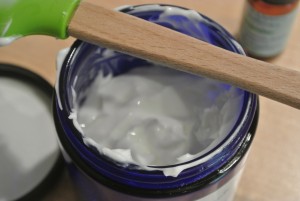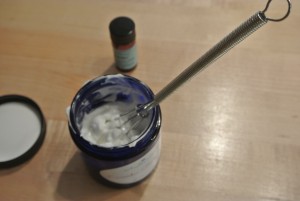Quick Essential Oil Body Creams
 As an aromatherapist, I love experimenting with making body creams and body lotions from scratch. It’s fun adding herbal oils I have infused myself and experimenting with different butters, herbs, and essential oils to get that perfect blend and product.
As an aromatherapist, I love experimenting with making body creams and body lotions from scratch. It’s fun adding herbal oils I have infused myself and experimenting with different butters, herbs, and essential oils to get that perfect blend and product.
Sometimes, however, I don’t have the time to make a luscious body lotion from the beginning to end. I need a quick product that will mix up in minutes but still have the healing properties and lovely scent I want. I’d like to share with you my go-to cream that I use when I don’t have time to make one and then show you how easy it is to customize it to your liking.
Favorite Body Cream
- Clean, dry jar (PET plastic or glass)
- ABC (Aloe Based Cream) cream or other unscented cream
- Essential Oils of your choice
Find an unscented cream that you like and keep a supply of it on hand to use for blending with essential oils. My favorite is called ABC Cream (you can click on the link to purchase a jar of it from my online store). You may already have one of your own that you like.
Take the clean, empty jar and fill it half-way with the body cream. Now, decide which essential oil(s) to  use. You can choose your EO based solely on its scent, by its purpose, or a combination of both. For example, if you love the smell of lavender, then you may choose lavender because of its fragrance. If, however, you have a certain purpose in mind for your cream, then you will want to choose an EO based on its historical therapeutic properties. You may also create a blend of about three to five oils. Each of the oils enhances the effect of the other. If you are blending for fragrance, open each vial you are considering for a blend and carefully hold all of them under your nose, wafting the fragrance so you can see if it’s pleasing to you.
use. You can choose your EO based solely on its scent, by its purpose, or a combination of both. For example, if you love the smell of lavender, then you may choose lavender because of its fragrance. If, however, you have a certain purpose in mind for your cream, then you will want to choose an EO based on its historical therapeutic properties. You may also create a blend of about three to five oils. Each of the oils enhances the effect of the other. If you are blending for fragrance, open each vial you are considering for a blend and carefully hold all of them under your nose, wafting the fragrance so you can see if it’s pleasing to you.
Here’s a chart of some of my favorite essential oils to help you choose. Of course, there are many others to explore as well.
| Essential Oil | Benefits |
| Bergamont | Antidepressant; uplifting; phototoxic, so use sunscreen |
| Clary Sage | Women’s Oil; antispasmodic; PMS; cramps; mood swings |
| Eucalyptus | Affinity with the respiratory system; expectorant; antimicrobial |
| Frankincense | Analgesic; anti-inflammatory; anti-microbial; stress; immune enhancer; irritated skin; mature skin |
| Geranium (Rose) | Balancing; mood swings; astringent; anti-inflammatory |
| German Chamomile | Anti-inflammatory; soothing for skin |
| Lavender | Sedative; soothes anxiety; mood swings; irritability; scars; stings/bites; burns (great added to ABC cream for sunburn) |
| Lemongrass | Antimicrobial; analgesic; antifungal; add to DIY cleaning formulas |
| Peppermint | Analgesic; relieves nausea; muscular aches and pains; cooling |
| Rosemary | Stimulating; affinity with respiratory system; enhances memory; use with caution if you have epilepsy or high blood pressure |
| Ylang Ylang | Aphrodisiac; calming; nourishing (can lower blood pressure, so use cautiously if you have low blood pressure. |
Once you have decided upon your essential oils, you need to figure out the dilution rate. For a healthy adult, a dilution range of 3 to 5 percent is good for body creams. For a 4 oz bottle, that would mean  you would add a total of between 72-120 drops of essential oils.
you would add a total of between 72-120 drops of essential oils.
Add your oils to the cream and mix well. Then add the rest of the cream and mix well again to evenly dispurse the essential oils through the cream. You could also mix this in a glass or stainless steel bowl and then add to the jar when you are finished, being careful to get all of the mixture.
And there you have it! Be sure you write down the dilution rate of the essential oils so the next time you make your body cream you’re ready. Enjoy! What blend did you come up with? Leave a comment and let me know!


